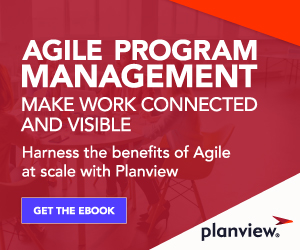
Are you scaling Agile in your enterprise? It’s a challenge to take what makes one Agile team successful and amplify that across an organization. Yet, it’s becoming a necessity as organizations seek to leverage the benefits of Agile to create innovative digital products and services.
For example, an airline may have a sleek mobile app, but that must connect seamlessly to a green screen-driven, legacy system for ticketing. Regulations that require compliance by a certain date (think GDPR), involve coordination among many departments, systems, and technologies. New applications and services can blend together people, processes, and technologies in ways never before imagined.
These create complex situations where a single team can’t make impactful business changes. As your initiatives grow, multiple teams need to work together. Naturally, as more teams are involved, dependencies arise which create handoff and communication delays.
This is why having a plan for how you will scale agile is so critical. Scrum or Kanban alone don’t provide an answer. It’s one thing to successfully implement Agile within individual teams. It’s quite another to extend it across teams to deliver quickly on shared objectives and a common mission. Agile-scaling frameworks such as SAFe, LeSS, and DaD are a good place to start but aren’t the only considerations.
These are typical challenges to keep in mind when scaling agile:
- Visibility and Alignment. How do you relate your teams’ work to the company’s strategy? How do you communicate status and progress to higher-level stakeholders?
- Accountability. How do you evaluate performance for the business and the value you are delivering?
- Coordination and Cross-functional Collaboration. How do you manage multiple teams and cross-team dependencies to deliver value? How do you communicate effectively across the organization, in ways that are easy for all users?
- Funding. How do you fund values streams or products in a way that aligns levels of investment with goals and metrics?
- Capacity. How do you balance across value streams as organizational priorities change?
To help solve these challenges, here are five steps for scaling agile success across teams in support of larger organizational objectives.
1. Leverage Lean Principles to Improve Flow
Fundamental Lean practices are to deliver fast, eliminate waste, optimize the whole, build in quality, and have respect for people. Teams can espouse these principles by focusing on the work and the processes through which work flows. They manage work as a system, prioritizing value delivery with every decision they make. Using Lean principles, you can expand Agile methods beyond Scrum to address the entire product creation process via empowered, cross-functional teams and continuous improvement processes.
2. Foster Cross-team Collaboration and Coordination
Key to scaling Agile is facilitating coordinated teams with common goals and aligning planning cycles. Organizations need to foster collaboration between teams both culturally and technologically. Information and interactions across teams should be connected—integrated and bi-directional.
Cross-team coordination is vital to align to program deliverables and prioritize work across teams. Managing team dependencies, processes, and handoffs requires a way to gather and analyze cross-team information. This includes visibility into each team’s flow of work and how that impacts larger programs and initiatives. Common planning cadences make this possible, enabling teams to more easily collaborate and address the challenges around handoffs, shared priorities, and dependencies.
3. Expand Agile Focus Toward Product and Value Stream Delivery
Customers—internal and external—are increasingly the recipients of Agile teams’ work, as organizations strive to deliver interconnected, digital products and services. To be successful, organizations must think, plan, and manage in terms of these end products and services.
Organizations can better handle all this complexity at scale by moving to product-based (rather than project-based) delivery models. With a product-centric approach, teams define what they will build, deliver, and operationalize. By considering the entire value stream—the series of steps required to deliver value to the customer—teams can more quickly identify innovative solutions to meet customer needs.
4. Rethink Strategic Planning and Portfolio Management
Strategic planning and portfolio management is evolving as businesses move toward agile ways of working. It’s critical to couple company’s goals, strategic plan, and portfolio vision with the agile work in process. A lean approach to portfolio management can help ensure that agile delivery supports strategic objectives by keeping the focus on delivering quickly, measuring results and adjusting.
Roadmaps that align to the strategic plan are essential to bringing together the various initiatives, funding, and target timeframes. As things change, you need to pivot quickly as well as plan, analyze, and prioritize investments in the context with the entire portfolio.
5. Fund Iteratively, Adjust Frequently, Measure Consistently
Product-based portfolios and delivery models require funding models to evolve from projects to products, initiatives, and value streams. The rapid pace of agile requires dynamic funding, enabling reallocation as priorities shift, experimental concepts don’t pan out, and new, promising ideas arise.
Organizations need to focus tangible product and business metrics to measure the benefits by team, value stream, and portfolio. For example, what is the outcome of a particular epic and what will it cause to happen? How can we measure its impact?
Scaling Agile Requires the Right Partner
While enterprise agile frameworks provide a place to start, there’s not a prescribed path to scaling agile for your organization. But you don’t need to fly solo. Look for a partner who will empower your organization to successfully integrate Lean-Agile delivery with strategic planning and portfolio management.
No matter where you are along your journey, Planview can support your business in scaling agile. Planview’s experience and focus on best practices for Lean-Agile delivery, combined with our software platform to accommodate a range of work and resources, can help you achieve your strategic goals and initiatives.
Stay tuned to the Planview Blog—subscribe today to learn more best practices for scaling agile within your organization.






